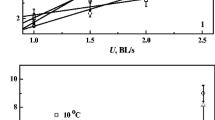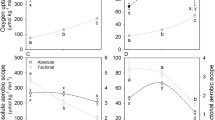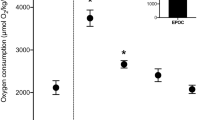Summary
Resting weight-specific oxygen consumption of the cryopelagic Antarctic nototheniid Pagothenia borchgrevinki at 0°C was 39.6 ml kg-1 · h-1 for a 50 g fish, with oxygen consumption being described by the regression equation: log10 VO2(ml/h)=−1.104+0.825 log10 Mb (g). These values are considerably below those raported by Wohlschlag (1964a,b). VO2 max. in forced swimming was described by the regression equation: log10 VO2 max = −0.507+0.823 log10 Mb. Despite low basal metabolism, factorial aerobic scope is similar to that reported for most other teleost fish, as is the cost of net transport. Myotomal muscles were used only at the highest swimming speeds and once they were recruited the fish fatigued rapidly. After swimming, oxygen debt was repaid rapidly, with a half-time of 20 min.
Similar content being viewed by others
References
Andriashev AP (1970) Cryopelagic fishes of the Arctic and Antarctic and their signficance in polar ecosystems. In: Holdgate MW (ed) Antarctic Ecology, vol 1. Academic Press, London, pp 297–304
Beamish FWH (1978) Swimming capacity. In: Hoar WS, Randall DJ (eds) Fish physiology, vol VII. Academic Press, New York, pp 101–185
Bennett AF (1978) Activity metabolism of the lower vertebrates. Annu Rev Physiol 40:447–469
Blazka P, Volf M, Cepela M (1960) A new type of respirometer for the determination of the metabolism of fish in an active state. Physiol Bohemoslov 9:553–560
Brett JR (1965) The relation of size to the rate of oxygen consumption and sustained swimming speeds of sockeye salmon (Oncorhynchus nerka). J Fish Res Board Can 22:1491–1501
Brett JR, Groves TDD (1979) Physiological energetics. In: Hoar WS, Randall DJ, Brett JR (eds) Fish physiology, vol VIII. Academic Press, New York, pp 279–352
Clarke A (1983) Life in cold water: the physiological ecology of polar marine ectotherms. Oceanogr Mar Biol Ann Rev 21:341–453
Davison W, Forster ME, Franklin CE, Taylor HH (1988) Recovery from exhausting exercise in an Antarctic fish, Pagothenia borchgrevinki. Polar Biol 8 (in press)
Davison W, Macdonald JA (1985) A histochemical study of the swimming musculature of Antarctic fish. NZJ Zool 12:473–483
DeVries AL (1970) Freezing resistance in Antarctic fishes. In: Holdgate MW (ed) Antarctic ecology, vol 1. Academic Press, London, pp 320–328
DeVries AL, Eastman JT (1981) Physiology and ecology of notothenioid fishes of the Ross Sea. J R Soc N Z 11:329–340
DeWitt HH (1970) The character of the midwater fish fauna of the Ross Sea, Antarctica. In: Holdgate MW (ed) Antarctic ecology, vol 1. Academic Press, London, pp 305–314
Dunn JF, Johnston IA (1986) Metabolic constraints on burst-swimming in the Antarctic teleost Notothenia neglecta. Mar Biol 433:433–440
Eastman JT, DeVries AL (1982) Buoyancy studies of Notothenioid fishes in McMurdo Sound, Antarctica. Copeia 1982:385–393
Farmer GJ, Beamish FWH (1969) Oxygen consumption of Tilapia nilotica in relation to swimming speed and salinity. J Fish Res Board Can 26:2807–2821
Holeton GF (1973) Respiration of arctic char (Salvelinus alpinus) from a high arctic lake. J Fish Res Board Can 30:717–723
Holeton GF (1974) Metabolic cold adaptation of polar fish: fact or artefact? Physiol Zool 47:137–152
Johnston IA, Walesby NJ, Davison W, Goldspink G (1975) Temperature adaptation in myosin of Antarctic fish. Nature 254:74–75
Jones DR, Randall DJ (1978) The respiratory and circulatory systems during exercise. In: Hoar WS, Randall DJ (eds) Fish physiology, vol VII. Academic Press, New York, pp 425–501
Macdonald JA, Montgomery JC (1982) Thermal limits of neuromuscular function in an antarctic fish. J Comp Physiol 147A:237–250
Montgomery JC, Macdonald JA (1984) Performance of motor systems in antarctic fishes. J Comp Physiol 154A:363–368
Morris DJ, North AW (1984) Oxygen consumption of five species of fish from South Georgia. J Exp Mar Biol Ecol 78:75–86
Muir BS, Niimi AJ (1972) Oxygen consumption of the euryhaline aholehole (Kuhlia sandvicensis) with reference to salinity, swimming, and food consumption. J Fish Res Board Can 29:67–79
Scholander PF, Flagg W, Walters V, Irving L (1953) Climatic adaptation in arctic and tropical poikilotherms. Physiol Zool 26:67–92
Soofiani NM, Priede IG (1985) Aerobic scope and swimming performance in juvenile cod, Gadus morhua L. J Fish Biol 26:127–138
Torres JJ, Weigle BL, Lancraft TM (1985) Metabolism of two antarctic mesopelagic fish species. Antarct J US 19:145–146
Walesby NJ, Johnston IA (1979) Activities of some enzymes of energy metabolism in the fast and slow muscles of an Antarctic teleost fish (Notothenia rossii). Biochem Soc Trans 7:659–661
Wells RMG (1986) Cutaneous oxygen uptake in the antarctic icequab, Rhigophila dearborni (Pisces: Zoarcidae). Polar Biol 5:175–180
Wohlschlag DE (1962) Metabolic requirements for the swimming activity of three antarctic fishes. Science 137:1050–1051
Wohlschlag DE (1964a) Respiratory metabolism and ecological characteristics of some fishes in McMurdo Sound, Antarctica. In: Lee MO (ed) Biology of the Antarctic seas, vol 1. American Geophysical Union, Washington DC, pp 33–62
Wohlschlag DE (1964b) Respiratory metabolism and growth of some antarctic fishes. In: Carrick R, Holdgate MW, Prevost J (eds) Biologie Antarctique (Scientific Committee on Antarctic Research, Proc 1st Symp Antarct Biol, Paris) Hermann, Paris, pp 489–502
Author information
Authors and Affiliations
Rights and permissions
About this article
Cite this article
Forster, M.E., Franklin, C.E., Taylor, H.H. et al. The aerobic scope of an antarctic fish, Pagothenia borchgrevinki and its significance for metabolic cold adaptation. Polar Biol 8, 155–159 (1987). https://doi.org/10.1007/BF00297069
Received:
Accepted:
Issue Date:
DOI: https://doi.org/10.1007/BF00297069




